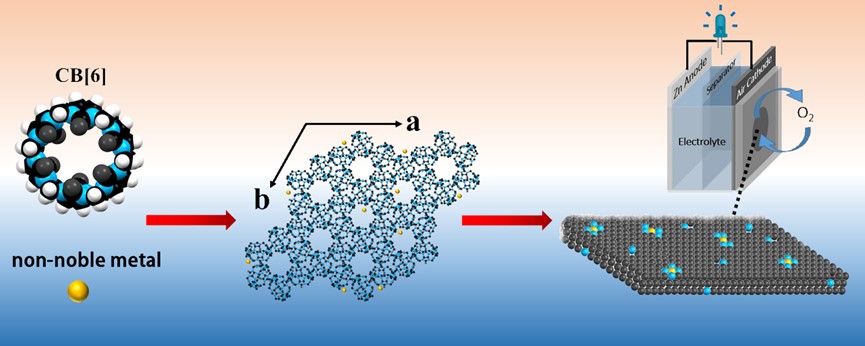In recent years, the exploration and exploitation of green energy promote the development energy transformation and storage techniques such as zinc-air batteries (ZAB).
ZAB has been considered as a crucial technical direction of electricity conversion and storage. It possesses the advantages including using aqueous electrolyte uniquely, larger power density and less cost. However, the oxygen reduction reaction (ORR) in discharging endures sluggish kinetics requiring high over-potential and leading energy voltage loss, which become the essential issue restricting the performance of ZAB.
In a study published in Applied Catalysis B: Environmental, the research group led by Prof. CAO Rong and Prof. CAO Minna from Fujian Institute of Research on the Structure of Matter of the Chinese Academy of Sciences reported a series of single-atom catalysts (M-NHC, M=Fe, Co, Ni) loaded on holey carbon matrix, in which Fe-NHC sample exhibited better catalytic ORR performance and cycle performance superior to commercial Pt/C +Ir/C catalyst when applied to ZAB.
The
 M-N-C single-atom catalysts possess the isolated M-N-C configuration and maximal atom utilization, presenting high activities for various electrocatalytic reactions. For the improvement of their performance, the support is crucial in requiring exposure and stabilization of sufficient atomically dispersed M-Nx sites as well as ample electrode/electrolyte interface. N-doped holey carbon materials possessing high surface area and abundant defects are suitable candidates.
M-N-C single-atom catalysts possess the isolated M-N-C configuration and maximal atom utilization, presenting high activities for various electrocatalytic reactions. For the improvement of their performance, the support is crucial in requiring exposure and stabilization of sufficient atomically dispersed M-Nx sites as well as ample electrode/electrolyte interface. N-doped holey carbon materials possessing high surface area and abundant defects are suitable candidates.
The researchers mixed supramolecular cucurbit[6]uril (CB[6]) self-assemblies and metal salts as precursor. With pyrolysis in N2 atmosphere, the mixture was transferred to carbonaceous material. The supramolecule self-assembly with regular tunnels and carbon/nitrogen sources was transferred to holey carbon matrix possessing hierarchical micro/mesoporous structure. The formation of holey structure does not rely on templates or pre/post treatments.
N2 adsorption-desorption analysis showed the sample displayed typical type-IV isotherms with hysteresis loops in the P/P0 range of 0-1.0, suggesting the existence of hierarchical micro/mesoporous structure. Non-local density functional theory (NLDFT) analysis also confirmed that carbon matrixes mainly included micropores and mesopores over the range of 1.0-2.0 nm and 2.5-10 nm respectively. The calculated pore distribution of CB[6]-derived M-N-C catalysts was in agreement with the holey structures owning diameter less than 10 nm distinguished in the high angle annular dark-field scanning (HAADF) transmission electron microscopy images.
The powder X-ray diffraction (PXRD) analysis results confirmed that no detective agglomeration of metal species occurred in the pyrolysis procedure. The only two peaks around 25° and 43° were ascribed to (002) and (100) planes of graphitized carbon.
Besides, the aberration-corrected
 high angle annular dark-field scanning transmission electron microscopy (
high angle annular dark-field scanning transmission electron microscopy (
 ACHAADF-STEM) and Fe K-edge X-ray absorption fine structure (XAFS) spectra confirmed the isolated Fe metal sites. Numerous highly dispersed bright dots detected in ACHAADF-STEM images with size less than 0.5 nm were attributed to heavier atomic dispersed metal atoms. X-ray absorption near-edge structure (XANES) and extended X-ray absorption fine structure (EXAFS) spectra of the sample differ from those of bulk metals and metal oxides.
ACHAADF-STEM) and Fe K-edge X-ray absorption fine structure (XAFS) spectra confirmed the isolated Fe metal sites. Numerous highly dispersed bright dots detected in ACHAADF-STEM images with size less than 0.5 nm were attributed to heavier atomic dispersed metal atoms. X-ray absorption near-edge structure (XANES) and extended X-ray absorption fine structure (EXAFS) spectra of the sample differ from those of bulk metals and metal oxides.
The Fe loaded N-doped holey carbon single-atom electrocatalyst (Fe-NHC) exhibited high activity with the half-wave potential (E1/2) of 0.89 V versus reversible hydrogen electrode (RHE) for ORR in alkaline condition, which was better than those of Co or Ni loaded catalyst and commercial Pt/C (E1/2 = 0.83 V). The corresponding Tafel slope calculated for Fe-NHC was the smallest one (53.7 mV/dec), which was lower than that of commercial Pt/C (74.7 mV/dec) manifesting a good kinetic process for the ORR on Fe-NHC electrocatalyst.
For the activity test of ZAB, the maximum power density of the ZAB employing Fe-NHC catalyst was as high as 157 mW/cm2, better than that of Pt/C + Ir/C catalyst (120 mW/cm2). The galvanostatic charge-discharge test was also used to examine the rechargeable ZAB with current of 10 mA/cm2.
For Fe-NHC catalyst, battery was able to work continuously over 60 h cycling without observed loss of the voltage gap for charge/discharge potentials. In contrast, the voltage gap of Pt/C + Ir/C catalyst dramatically increased after 4 h test. On the whole, Fe-NHC was a promising alternative catalyst with better activity and stability to replace precious metal-based catalysts in rechargeable ZABs.
This study holds great promise for fabricating catalysts with high surface area from macrocycle self-assembly in enabling reversible energy storage and conversion devices.







